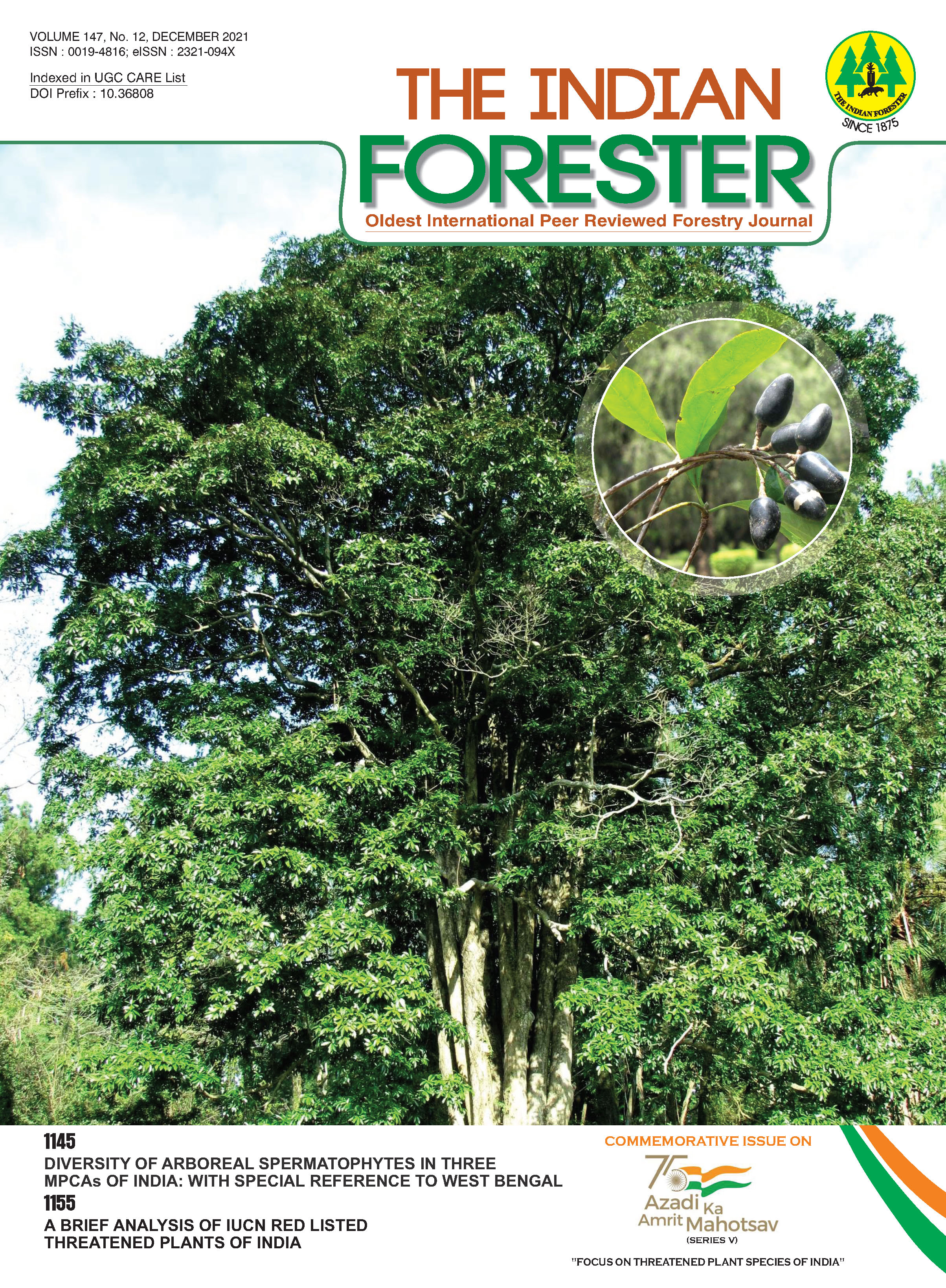Plant Community Distinctiveness of Peripheral Zone of Nongkhyllem Wildlife Sanctuary, Meghalaya, North-East India
DOI:
https://doi.org/10.36808/if/2021/v147i12/157705Keywords:
Conservation Practices, Forest Fragmentation, Heterogeneity, Species Diversity, Northeast India.Abstract
Present study was conducted during 2017-2018 in Nongkhyllem Wildlife Sanctuary, Meghalaya lies between 25°45'-26°00' N latitude and 91°45'92°00' E longitude. Data was collected and analyzed using the standard methodology. A total of 72 plant species were recorded in the study. Out of these 18 tree species (belongs to 13 genera and 11 families) of angiosperm were recorded and similarly 30 species of shrubs (28 genera and 21 families) and 24 species of herbs (19 genera and 16 families). The Margalef's diversity index for trees, shrubs and herbs were 10.00, 11.12 and 8.64 respectively and Shannon and Weiner diversity index were 2.67, 3.11 and 2.98 respectively for trees, shrubs and herbs whereas for Simpson Dominance index for trees, shrubs and herbs were 0.008, 0.003 and 0.005 respectively. Evenness for trees, shrubs and herbs were 0.92, 0.91 and 0.93 respectively. Knowledge of forest characteristics is an important factor for the formulation of conservation practices.References
Champion H.G. (1936). Indian Forest Records. Government of India Press.
Devi L.S. and Yadava P.S. (2006). Floristic diversity assessment and vegetation analysis of tropical semievergreen forest of Manipur, north east India, Tropical Ecology, 47: 89-98.
FSI. (1997). The State of Forest Report. Forest Survey of India, Ministry of Environment and Forests, New Delhi, India.
Haridasan K. and Rao R.R. (1985). Forest Flora of Meghalaya. 2 Vols. Bishen Singh Mahendra Pal Singh, Dehra Dun.
Kanjilal U.N., Kanjilal P.C., Das A., De R.N. and Bor N.L. (193440). Flora of Assam. 5 vols., Government Press, Shillong.
Keel S., Genetry H.A. and Spinzi L. (1993). Using vegetation analysis to facilitate the selection of conservation sites in eastern Paraguay, Conservation Biology, 7: 66-75.
Khumbongmayum A.D., Khan M.L. and Tripathi R.S. (2005). Survival and growth of seedlings of a few tree species in the four sacred groves of Manipur, Northeast India, Current Science, 88: 1781-1788.
Knight D.H. (1975). A phytosociological analysis of species rich tropical forest on Barro-Colorado Island: Panama, Ecological Monograph, 45: 259-289.
Lalfakawma S., Roy U.K., Vanlalhriatpuia S. and Vanalalhluna P.C. (2009). Community composition and tree population structure in undisturbed and disturbed tropical semi-evergreen forest stands of north-east India, Applied Ecology and Environmental Research, 7: 303-318.
Nath P.C. (2005). Vegetation analysis and tree population structure of tropical wet evergreen forests in and around Namdapha National Park, northeast India, Biodiversity and Conservation, 14.9: 2109-2135.
Neumann M. and Starlinger F. (2001). The significance of different indices for stand structure and diversity in forests, Forest ecology and Management, 145(1): 91-106.
Pandey H.N., Tripathi O.P. and Tripathi R.S. (2003). Ecological analysis of forest vegetation of Meghalaya. pp. 37-50 In: B.P. Bhatt, K.M. Bhuarbaruah, Y.P. Sharma and Patiram (eds.) Approaches for Increasing Agricultural Productivity in Hill and Mountain Ecosystem. ICAR Research Complex for NEH Region, Umiam, Meghalaya,
Sagar R., Raghubanshi A.S. and Singh J.S. (2003). Tree species composition, dispersion and diversity along a disturbance gradient in a dry tropical forest region of India, Forest Ecology and Management, 186: 61-7.
Shannon C.E. and Wiener W. (1963). The mathematical theory of communities. University of Illinois Press, Urbana Illinois. Simpson EH (1949) Measurement of diversity, Nature, 163: 688.
Simpson E.H. (1949). Measurement of diversity, Nature, 163: 688.
Sundarapandian S.M. and Swamy P.S. (2000). Forest ecosystem structure and composition along an altitudinal gradient in the Western Ghats, South India, Journal of Tropical Forest Science, 104-123.
Tynsong H. and Tiwari B.K. (2010). Diversity of plant species in arecanut agroforest of south Meghalaya, north-east India, Journal Forestry Research, 21: 281-286.
Downloads
Downloads
Published
How to Cite
Issue
Section
License
Unless otherwise stated, copyright or similar rights in all materials presented on the site, including graphical images, are owned by Indian Forester.





